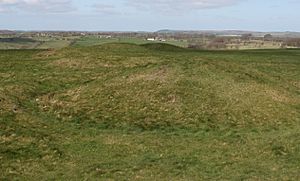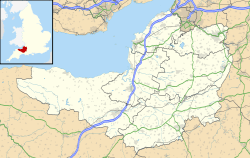Priddy Nine Barrows and Ashen Hill Barrow Cemeteries facts for kids
The Priddy Nine Barrows Cemetery and Ashen Hill Barrow Cemetery are groups of ancient burial mounds. These mounds are called round barrows. They were built during the Bronze Age, a time long ago when people used bronze tools. You can find them near a village called Priddy in Somerset, England. These sites are so important that they are protected as ancient monuments.
These barrows are located on high ground in the Mendip Hills. This area has many other ancient sites from the Neolithic period, which was even older than the Bronze Age. Experts believe these barrows might be connected to the Priddy Circles. The Circles are large, mysterious earthworks about 750 meters (about half a mile) north of the barrows.
The Ashen Hill cemetery has six bowl barrows and two bell barrows. These are different types of burial mounds. They are lined up from east to west. The Priddy Nine Barrows are split into two groups: one has seven barrows, and another has two barrows a little bit away.
In 1815, people dug into some of these barrows. They found cremation burials, which means people's ashes were buried there. They also found grave goods, which are items buried with the dead. These included things like bronze daggers and spearheads. A special survey using magnets later suggested there might be three more barrows hidden underground.
Contents
Where Are These Ancient Sites?
The fields where these ancient monuments are found are about 750 meters (about half a mile) south of the Priddy Circles. The Priddy Circles are four large, round earthwork enclosures. Experts think they were used for special ceremonies in the Neolithic period, like a henge.
The barrows are about 1 kilometer (0.6 miles) east of Priddy village. They are also about 0.5 kilometers (0.3 miles) west of Stock Hill, which is a forest area. Between the barrows and Stock Hill is the Priddy Mineries. This area is a nature reserve and part of the Priddy Pools Site of Special Scientific Interest (SSSI). People used to dig for lead here for many centuries.
The cemeteries sit on the two highest hills in the area. Priddy Nine Barrows is 307 meters (1,007 feet) above sea level. Ashen Hill is a bit lower at 295 meters (968 feet).
What Do the Barrows Look Like?
Ashen Hill Barrows
The Ashen Hill Barrow Cemetery is the most northern group of mounds. It has six bowl barrows and two bell barrows lined up from east to west. A bowl barrow looks like an upside-down bowl. A bell barrow has a flat area around the mound, like a bell.
Each mound is between 14 meters (46 feet) and 20 meters (66 feet) wide. They rise up to between 2 meters (7 feet) and 3 meters (10 feet) high. Each barrow used to have a ditch around it. Over time, these ditches have filled in. To the north and east, there are other signs of digging. But these were from lead mining, not ancient burials.
Priddy Nine Barrows
The southern area has the Priddy Nine Barrows. This group is split into seven round barrows in one line and two other barrows nearby. The seven barrows are on top of North Hill. Each one is between 12 meters (39 feet) and 27 meters (89 feet) wide. They are between 1 meter (3 feet) and 3 meters (10 feet) high.
Each barrow also has a shallow ditch around it that has partly filled in. Some of the barrows have dips on top. These dips were probably made by people digging into them in the early 1800s.
The two other bowl barrows are about 150 meters (490 feet) north of the main group of seven. There is about 20 meters (66 feet) between these two barrows. Like the others, they are about 20 meters (66 feet) wide. They rise to between 2.5 meters (8 feet) and 3 meters (10 feet) high.
People have called them Priddy Nine Barrows since the year 1296!
Discoveries and Investigations
In 1815, an archaeologist named John Skinner did some digging here. He found cremation burials, where people's burnt remains were placed in an oval stone box. This box was covered by a flat stone, just below the ground level from the Bronze Age.
Skinner also found grave goods buried with the remains. These included bronze daggers, a spearhead, pretty amber beads, a bronze ring, and a small cup. These items tell us about the people who lived here long ago.
Later, in 1894, a team led by Herbert E. Balch also dug into at least one of the Ashen Hill Barrows.
These sites were officially protected as Scheduled Monuments in 1933. This was probably done to stop more digging by local groups and schools.
A special survey using magnetometry (which uses magnets to look underground) was done between the seven barrows and the two separate ones. This survey suggested there might be three more barrows hidden there. However, the results were not completely clear. It looked like there might be a ring ditch (a circular ditch) from another barrow. But lead mining in the area might have disturbed any other hidden barrows.




